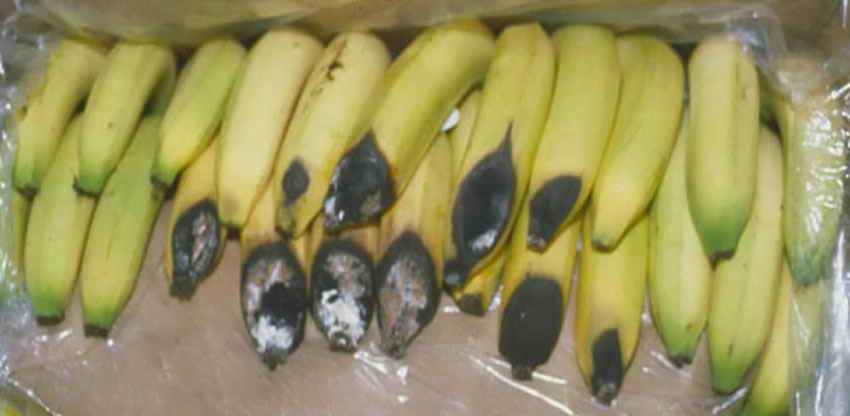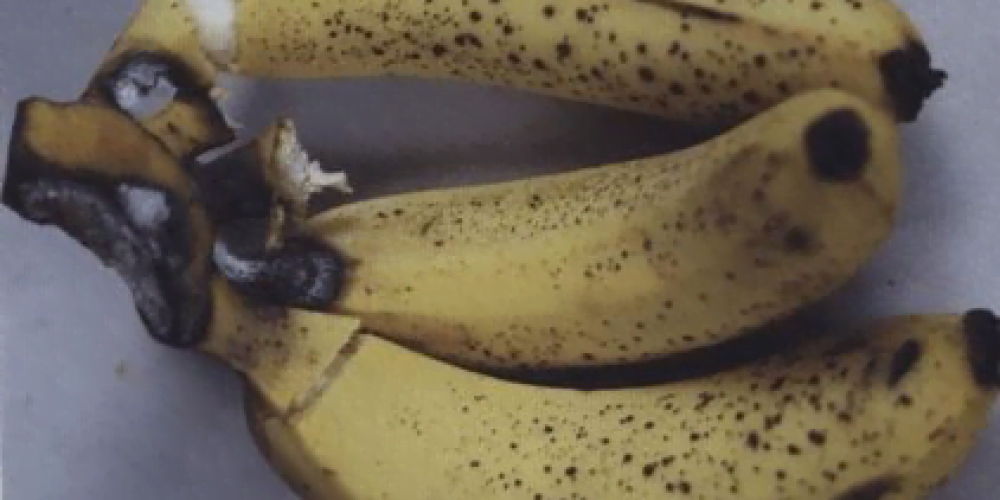Table of contents of the article
ToggleBanana crown rot is a serious fungal disease that affects plant growth and production. In this article from “WORLD OF PLANTS,” we discuss the most prominent symptoms of this disease and how to prevent it.
Symptoms of banana crown rot
Banana crown rot is an important disease of bananas after harvest and during transportation. Banana crown rot caused by Fusarium is the main disease after anthracnose during post-harvest storage and transportation. It mainly causes banana finger shedding, shaft rot and fruit rot, often causing huge economic losses. Banana farmers often refer to banana crown rot as “white mold”.
Pathogenic bacteria of banana crown rot first invaded from the cleft of the fruit axis, and first damaged the fruit axis. After combing the banana ear, a white layer of cottony woolly mold appeared on the slit of the banana comb and caused the fruit axis to rot. Scattered fruit fingers. In the late stage of the appearance of banana crown rot, the peel of the fruit bursts, the pulp is hard, and it is not easy to ripen and turn yellow. When the ripe green fruit is damaged, the affected bananas turn brown from the crown, and later turn dark brown to black. The affected part has no clear boundaries, then the affected part gradually extends from the crown to the end of the fruit. When the air is humid, the affected part produces a large number of succulent white molds, that is, fungi and fruiting bodies of pathogenic bacteria, and produces – pink bodies, which are conidia of pathogenic bacteria.
Causes of banana crown rot
Banana crown rot pathogens can infect bananas through mechanical wounding. After unraveling and combing the banana, a large area of wound is left at the incision, which becomes the point of invasion of pathogenic bacteria. In the banana transportation process, the traditional harvesting, packing and transportation used for a long time often results in scars in the fruit. In addition, the high temperatures and high humidity of the northern caravan in summer and fall often lead to a lot of fruit rot. When bananas are stored in the place where they are produced, sealed packaging in polyethylene bags can extend the green life of the fruit, but the micro environment with high temperature, high humidity and high carbon dioxide concentration can easily lead to crown rot. Fruits harvested after rain or irrigated before harvest are also highly susceptible to disease. If the ripeness of the fruit is too high, it is already yellow and ripe before reaching the destination, which often results in a lot of spoiled fruit during transportation.

Ways to prevent banana crown rot
The key to preventing banana crown rot is to reduce mechanical damage caused by storage and transportation links such as harvesting, carding, packing, transportation and sales. Packed in corrugated boxes, handling with care during transportation can reduce mechanical damage to the fruit. In addition, bananas should not be irrigated within 10 days before harvest, and harvested 2 to 3 sunny days after rain, which may reduce the water content of the fruit at a later stage of growth, and can also effectively prevent the occurrence. From banana crown rot.
The use of chemical preservatives is a necessary measure nowadays. Mix 50 percent carbendazim, lipid-rich membrane water emulsion – and water in a ratio of 1:5:1000, then soak the fruit (and prevent banana anthracnose), or use 50 percent wettable iprodione powder 500 times liquid plus 45 percent after mixing with 500 times liquid than thiabendazole agent, soak the fruit for 12 minutes, and can air-dry or air-dry and then pack it, get better control effect. Immediately after harvesting bananas, use 50 percent carbendazim WP 500 times liquid, 50 percent prochloraz manganese salt WP 2000 times liquid, 45 percent thiabendazole 600 times liquid or 50 percent wet guanoctin powder 1500 times liquid to treat fruit soaking, air {{20}} drying. Or air-drying and packing, can reduce the occurrence of crown rot. Low temperature. (1315°) Transport can significantly reduce the incidence of crown rot.
How to protect the plant from crown rot
Complete control of mold species is not possible, but the severity of pathogens can be limited, and successful control depends on the characteristics of the pathogen, host crops, and environment. Controlling the environment, rotating crops, using resistant varieties, and reducing soil compaction are effective and uncomplicated means of managing the disease.
Planting seedlings in warmer soil and allowing plants to emerge quickly helps reduce damage. Crop rotation also contributes to reducing the amount of inoculum that leads to infection. A small number of resistant varieties with moderate resistance to mold can be used, but they produce smaller crops and quantities than standard varieties. Reducing Soil pressure on water drainage and plant aeration.
One specific chemical option is to spray a chemical pesticide called PCNB, which is known to be the best solution to reduce seed spread on host plants. To reduce the disease, certified sclerotia-free seeds can be planted. Seed growers must purchase sclerotia-free seeds when planting their crops. Sclerotinia can spread through the soil and may not show symptoms immediately. Although fungicides are not the most effective way to manage this disease, there are some that have been approved by the USDA to control pathogens, and chemical company representatives can recommend With a range of fungicides that will be most effective on crops in relation to stag rot.
Crown rot is usually not a problem if seeds are kept free of wet, poorly draining areas, and susceptible crops are avoided. Diseases caused by these pathogens are more severe in soil that is moderately moist and whose temperature ranges between 15 and 18 degrees Celsius.
How does crown rot appear?
The pathogen is known to prefer warm, humid weather. Plant diseases usually occur in the early summer months, and most disease symptoms do not appear until the end of summer. Consequently, most farmers do not realize that their crop is infected until it is time to harvest. A range of environmental factors have been linked to the spread of plant diseases, such as the presence of host plants, rainfall or irrigation, and high temperatures in the spring and summer. In addition, it is also known that reducing soil drainage due to various techniques such as soil compaction creates suitable environments for the spread of plant diseases, and these traits can be transmitted by wind, water or soil movement between host plants.
The severity of infection can vary, and for heavily infested spots, infection can be very devastating to the farmer. This results in significant yield losses ranging from 25% to 100%, in addition to the deterioration of the industrial quality of crops due to increased levels of sodium, potassium and nitrogen. Given the number of hosts targeted by this pathogen, there are many negative and devastating impacts on a variety of crops. This pathogen is the second most destructive disease to plants.
In conclusion, we would like to note that we, at the world of plants website, offer you all the necessary services in the world of plants, we provide all farmers and those interested in plants with three main services::-
- Artificial intelligence consulting service to help you identify diseases that affect plants and how to deal with them.
- Blog about plants, plant diseases and care of various crops ... You are currently browsing one of her articles right now.
- An application that provides agricultural consultations to clients, as well as a service for imaging diseases and knowing their treatment for free – Click to download the Android version from Google Play Store، Click to download the IOS version from the Apple App Store.
sources:-




